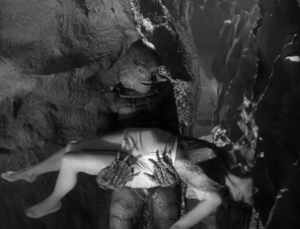
I hate 3D on general principal and consider it a classless, money-grubbing gimmick, trotted out whenever panic grips the hearts of backward-looking Hollywood bean-counters. I reached this conclusion early in life after coming to grips with just how awful Freddy’s Dead, Jaws 3D, and Friday the 13th Part 3D really were. But every critic has that one 3D skeleton in the closet. One black mark on their critical scorecard. One film they like in spite – or perhaps because of – the occasional distracting bit of visual cheese.
Creature from the Black Lagoon is mine. Despite coming out twenty-three years after the other monster movies that celebrated their sixtieth anniversaries in 1991, it made its way onto VHS and into my eight-year-old-self’s collection. I can’t think of a better time to give yourself a classical monster education. And what could be more classical than ripping-off King Kong‘s “beauty and the beast” angle?
But I’m getting ahead of myself.
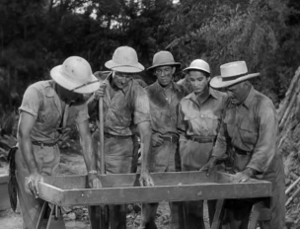
Unfortunately for my conscience, this movie wouldn’t exist without 3D. It’s producer William Alland (who played Our Reporter in Citizen Kane) originally heard the legend of an Amazonian fish-man in 1941 from cinematographer Gabriel Figueroa…who’d go onto film, among other things, John Ford’s The Fugitive and Two Mules for Sister Sara. For whatever reason, Alland sat on the legend for ten years, eventually turning it over to Universal Pictures house-writers Harry Essex (who’d go on to write What Ever Happened to Baby Jane?) Maurice Zimm (who’d go on to write…at least eight episodes Perry Mason) and Arthur Ross (who’d go onto write Satan’s School for Girls. Funny where some people’s career paths take them, isn’t it?)
By the time Creature had an actual script, the Vincent Price-headlined House of Wax was raking in loads of cash for Warner Brothers. Universal couldn’t help but answer a month later with It Came from Outer Space. It‘s director, Jack Arnold, was the natural choice to helm what I’m sure Universal considered, at the time, to be the next logical step: an underwater 3D movie. That’ll pack the theaters, right?
Right. And it’ll make an eight-year-old shut up and pay attention, because the movie opens with the formation of Earth itself! Fantasia made us wait 40 minutes for stuff like that, but Creature from the Black Lagoon‘s all like, “Boom! There you go. That’s how you begin: at the beginning! Of everything! Suck those nuts.” Eight-year-old me admired the audacity of this, the same way he admired films that started off with a nuclear war. (With Damnation Alley being the winner of those particular Olympics.) Significantly-older me can’t help wondering if that’s Criswell providing our opening narration. It isn’t, but it’s fun to dream.
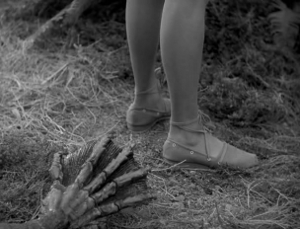
Also, I gotta smile at Our Humble Narrator’s tortured attempts to reconcile geological history with the opening lines of Genesis. “In the beginning,” he intones, “God created the Heaven and the Earth. And the Earth was without form and void.” Cut to “the planet Earth, newly formed and cooling rapidly for millions of years.” Our Humble Narrator guides us through the formation of continents, oceans, and finally life itself. “The record of life is written on the land. Where, fifteen million years later, Man is still trying to read it.”
I can just see some asshole Fundamentalist in the audience going, “You mean four thousand years, right? Aww…fuck this movie. Secularist propaganda’s what this is. Probably Communist. That’s it! 3D is a Communist plot!” We’ll forgive our three writer’s complete refusal to do any research into the actual time-scale of evolution…or anything that might’ve let accurate scientific information come within miles of their script (which is full of Scientists doing Scientific things…like monologueing). However, I reserve the right to mock them for it. Even eight-year-old me could call “bullshit” on some of bullshit we’ll hear later on.
Anyway. One person “still trying to read” the record of life is Dr. Caral Maia (Antonio Moreno), a paleontologist exploring the Amazon jungle’s finer (California-looking) rocky hillsides. He and his Indian Companions (Rodd Redwing and Perry Lopez) spend the opening scene going gaga over the fossilized hand of what appears to be a fishman, jutting ominously from the stones (and right into Arnold’s camera). Maia carts the find home, leaving his Indian Companions to the tender mercies of that un-fossilized fishman who’s been observing them All This Time.
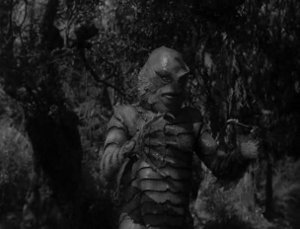
The Creature – or Gillman, whatever you want to call him – is backed throughout his trilogy by another iconic score, composed by the once-again-uncredited Henry Mancini and Herman Stein, with a little help from Hans J. Salter. You might not know his name, but you’ll certainly know his work, as Slater either composed or directed the music for pretty much every Universal horror film after Son of Frankenstein. That’s part of why Creature feels like such a worthy successor to those films. Its score’s filled with enough big brass to make Cab Calloway dance…and an undertheme that may have inspired John William’s score for Jaws. It’s as classical as the structure of this film’s story, because everyone knows Big Brass = prehistoric monsters, right? Ask any Godzilla fan.
Meanwhile, Maia arrives at the Instituto de Biologia Maritima, temporary home of Maia’s former students, Kay Lawrence (Julie Adams) and Dr. David Reed (Richard Carlson). Impressed with Maia’s find, Dr. Reed convinces el Instituto’s head, Mark Williams (Richard Denning) to fund a little field trip for all involved, since it looks like el Instituto’s entire staff of…what, five people?…follows Maia back to the rock wall.
Dr. Reed used to be a personal hero of mine, mostly because his name was David and he got to scuba dive for a living. (That’s all you need to do to be a marine biologist, right?) Now I see David Reed for the sexist, speechifying douche he really is, and wonder what the holy fucking hell his girlfriend sees in him. I’ll admit, sometimes you need someone to make a Stirring Speech and get the plot moving, but there’s a wide gap between the stirring speeches here and the ones Bradbury wrote for that last Arnold/Carlson collaboration:
David: More and more we’re learning the meaning and the value of marine research. Look, look over here – this lung fish. The bridge between fish and the land animal. There are many thousands of ways nature tried to get life out of the sea and onto the land. This one failed. He hasn’t changed in millions of years. But here – here we have a clue to and answer. Someday spaceships will be traveling from Earth to other planets. How are human beings going to survive on those planets? The atmosphere will be different; the pressures will be different. By studying these, and other species, we add to our knowledge of how live evolved, how it adapted itself to this world. With that knowledge, perhaps we can teach man to adapt themselves to some new world of the Future.
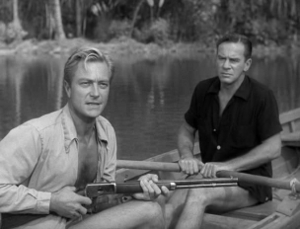
I’m with Mark: it’s a “nice speech, David,” but it’s written so clumsily that typing it into this review (and reading it back…over and over and over) gave me one king hell of a headache. This is the first of many times our Heroic Scientist will link his own job to space exploration. Easy to see why he’d do that: space was the sexy topic of this era, as demonstrated by its glut of Alien Invasion and/or Space Exploration films. The parallel’s not even all that forced since both environments are inherently hostile to human life. There’d be no way for us to explore either without a whole mess of modern technology…meaning, in a stand-up fight with the average lifeform born into and bred for that environment, human beings are pretty much screwed.
In order to get screwed Our Humans must first rent a boat from my favorite character, Lucas (Nestor Paiva), skipper of the fishing barge Rita and the closest thing to a Working Class Hero in this movie. Paiva’s one of those character actors with the power to disappear into his roles, which is probably why his career stalled out in (Mostly Ethnic) Character Actor Land. At least Paiva’s actually of Portuguese descent, the tenth child of two immigrant grocery store owners, so his is one of the few accents that fits the film’s setting.
So we’ve got a group of characters stuck on a boat, going upriver on a journey of discovery they’ll soon regret. This is Monster Movie 101, folks. If I had to pick a literary antecedent, I’d pick Joseph Conrad’s Heart of Darkness because Heart of Darkness is both awesome and awesomely influential.
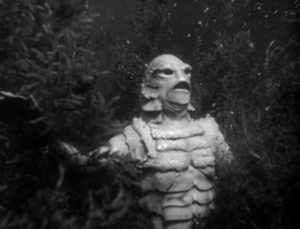
But back to our doomed crew as they trudge upriver, to a place Lucas knows as “the Black Lagoon; a paradise.” Staring off into the stock footage with his best girl on his arm, Dr. Reed can’t resist the chance to fuck up another scientific fact:
David: This is exactly like it was a hundred and fifty million years ago, when it was part of the Devonian Era.
Yeah, you’re off by about two hundred and ten million years there, Doc. Thank Christ numerical dyslexia has no effect on fossil-finding instincts or this movie would never pick up. But it does, mightily, once we get to the Black Lagoon and Our Scientists make their presence known to its sole inhabitant. James C. Havens directed all the underwater sequences that make this film memorable, meaning this is as much his picture as Jack Arnold’s. A lot of his choices might baffle – he lets a lot of shit float into the foreground, way past the point of blurriness – until you remember this movie was originally shot and shown in 3D. All those fish and plants were supposed to jump out at you, along with the Gillman himself. Both directors employ a lot of framing and perspective tricks to heighten the illusion, my favorite being a shot of the Creature’s arm as it reaching through a porthole.
Before that, thought, Mark and David go swimming, the Creature observing them all the while. Then Julie Adams decides to take a dip, triggering the obligatory inter-species lust that’s killed more monsters than Super Science and American Pioneer Spirit combined. Mark immediately gets the hot idea to kill the Creature and cart it back home. (“We must have proof!”) David (initially…and unfortunately) takes the “we can learn more from it if it’s alive,” track. We’re supposed to side with him because he’s Richard Carlson, Savior of Mankind, while Mark’s a money-grubbing asshole who pulls rank like he’s working it to climax:
David: You don’t sound like a Scientist, you sound like some big game hunter out for the kill.
Mark: We may not be back home, David, but you still work for me.
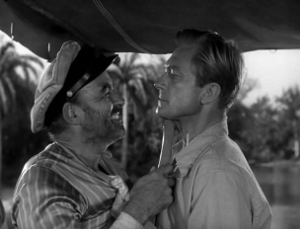
And that gives you permission to antagonizing the fish monster who can tear your nets like paper? And do the same to human flesh? The proper resonse is, Fuck you, buddy. Keep your hands off my Julie Adams! But, then again, Dr. Reed’s no great shakes either. He obviously never caught a revival showing of King Kong or he’d know exactly what the Gillman was after. And how to trap it.
Lacking any genre savvy, the movie proceeds a bit like this: Our Humans try to capture the Creature, it escapes, and one of the incidental characters I haven’t mentioned yet dies. There are plenty of them, because the monster has to kill someone, and we have to save our main character deaths until the end. Again, this is Monster Movie 101, and watching this flick you’ll see the modern iteration of that formula run through its first successful field test. This is the foundation of every Slasher film you’ve ever seen and most of our modern monster movies, from Alien on down. That’s why this film’s important, and why it deserves attention still today. But here comes the punchline
Because the movie’s not that good. The characters are bland and their development’s stymied by the fact we never really get to know them until we get to the Black Lagoon. Go back to Heart of Darkness, which wouldn’t be nearly as awesome if it cut right from the mouth of the river to Kurtz’s camp. Hell, you don’t even have to go back that far: look at Howard Hawks’ Thing from Another World. In both cases, we get extended build-ups full of lively interactions from enthusiastic actors, allowing us time to get to know these characters before the stresses of survival expose their inner foibles.
Here, thanks to all the bad dialogue (it’s getting easier and easier to believe Harry Essex just stuck his name on Ray Bradbury’s It Came from Outer Space script), everyone’s foibles are on display from the word Go. Mark’s an asshole. David’s a patronizing fool. Dr. Maia’s the Elder Scientist with no speeches to give, since David’s monopolized them. Julie Adams is…Julie Adams. And Lucas is Brazilian. None grow over the course of their jungle adventure, so my contempt for them gets to grow unchecked, like any good tumor.
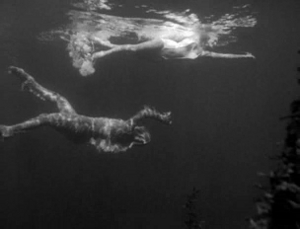
All of which allows me to unabashedly root for the monster, another through-line connecting this to previous Universal outings. Played on land by Ben Chapman and underwater by Ricou Browning, the Gillman’s easily the best-looking monsters of his age. Designed by ex-Disney animator Millicent Patrick, the Creature’s a marvel of clashing textures. The contrast of rough and smooth scales, the glint of water on wet skin, and all the thousand and one subtle touches – like the way his gills move as he breathes – give him a verisimilitude other monsters of his period lacked. Not bad for a pair of $15,000 suits with creepy, dead-looking eyes. Even those fit into the Creature’s overall aesthetic. And they only become obvious once Jack Arnold insists on having the Creature walk directly into the camera. As if he were walking right towards (gasp) the audience!
Yes, it’s exactly the kind of gimmicky, throw-shit-in-our-faces 3D that Arnold’s last film avoided. Shows what I get for praising people. Watching this back-to-back with It Came from Outer Space really underlines what good dialogue (even Bradburyian soliloquies) can bring to the table, and how it can invigorate tales as old as time. Here, everything said is functional, in service of exposition. “We’ve got to do that thing!” “Okay, let’s do that thing, then.” “Oh shit! We can’t do that thing now! Here comes the monster!”
So Creature from the Black Lagoon, for all its fans and all its historical import, winds up being an average monster movie, even for its own time. On the other hand, Creature‘s real star, the Gillman, proved an above-average monster can raise your average monster movie up to grab an above-average slice of box office pie. Hence the increased focus on monsters throughout the 50s. Which – among many, many other things – gave the creature his opportunity…for revenge.
![]()
![]()
![]()

Your points about the plot and characters are undeniable, but I still can’t bring myself to not love this. Is it because I can’t remember a time before I’d seen this, seemingly every Saturday afternoon? Is it because my older brother loves this film with the kind of purity that is usually reserved for dog’s loving their owners? Is it because I think Julie Adams is insanely hot? Is it because the Gill Man is such a great monster suit? Is it because I just really like this basic plot? Because I love seeing Richard Carlson, Richard Denning and Whit Bissell doing their respective 1950s Monster/Sci-Fi movie things? I can’t really answer, but I do adore this film, despite it’s flaws. The sequels? Not so much.
I can agree with every single word of that. I’m kinda sorry this one came out the way it did. But in prep for this year’s anti-3D parade, I convinced myself I needed to see It Came from Outer Space before I settled into this one, originally intending it as an “do your homework before you play” kinda deal. Then It went and shocked me by being better than I remembered, forcing me to be honest with myself about my own feelings, re: this movie. I still like it fine, and it’ll always be a personal nostalgia trip but…yeah. What can I do but shrug?
Wait, I know: I can promise Revenge and Walks Among Us new assholes. Of course!
I look forward to you doing just that. When I revisited this in my 20s, I was pleasantly surprised that it remained a lot of fun. When I revisited the others? Good lord, those movies. John Agar makes you appreciate the Dicks from this film, and, while it makes an interesting companion piece to the waning days of Film Noir from which it hails, the fact that The Creature Walks Among Us wastes a good premise so that it can focus on a love triangle between really, really sketchy people is pretty unforgivable.